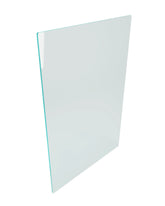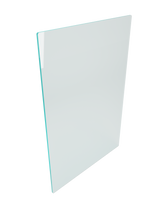Frameless glass pool fencing looks stunning — sleek, clean, and modern. But underneath all that minimalism is one of the most important components of the entire setup: the humble spigot.
The right spigot makes the difference between a fence that’s safe, compliant, and long-lasting… and one that causes problems for years.
So how do you choose the right spigot? This guide breaks down everything you need to know — from base plate vs core drill, to materials, finishes, and even earthing requirements.
Let’s dive in.
First, What Is a Spigot?
A spigot is the metal clamp or support that holds your frameless glass panel in place. Instead of using posts or rails, frameless systems rely on these sleek brackets at the base of each glass panel to keep everything upright and structurally sound.
Spigots sit on your surface or are recessed into it. They carry all the weight of the panel, so quality matters.
Two Main Types: Base Plate vs Core Drill
There are two primary types of spigots used in pool fencing:
1. Base Plate Spigots
These sit on top of your surface (concrete, decking, tiled slab) and are bolted down with anchors.
-
Easy to install
-
Good for retrofits
-
Visually tidy, especially with cover plates
-
Needs a solid substrate
Best for: Decks, tiled surfaces, slabs where drilling depth is limited
2. Core Drill Spigots
These are inserted into a core-drilled hole in your concrete or paver surface and secured with non-shrink grout.
-
Offers a sleeker look (no visible plate)
-
Slightly stronger in wind or uneven terrain
-
Often used in new builds or when concreting fresh
Best for: New concrete pours, wind-exposed areas, seamless aesthetics
Choosing the Right Material: 316 vs 2205 Stainless Steel
Your spigots will be living outside — and often near saltwater. Material choice matters.
316 Stainless Steel
-
Industry standard for pool fencing
-
Corrosion-resistant in most environments
-
Affordable and widely available
2205 Duplex Stainless Steel
-
Even higher corrosion resistance (ideal for coastal homes)
-
Tougher under mechanical stress
-
Often used in marine applications
If you’re within 5–10km of the ocean, it’s worth paying more for 2205.
Surface Finish: Satin, Polished, Matte Black, Gold & More
Once your spigot is installed, it’s highly visible. The finish you choose has a big impact on the overall aesthetic.
Popular finishes include:
-
Satin stainless: Timeless, brushed look that hides fingerprints well
-
Polished stainless: Shiny, reflective, ultra-modern
-
Matte black: Bold and contemporary — often used with black framing or posts
-
Gold/Brass-look: Used for luxe or Hamptons-style homes
-
Custom powder-coated colours: Match your exterior exactly (available from select suppliers)
Match your finish to your gate hardware and nearby fittings for a cohesive feel.
Earthing Requirements (Yes, It’s a Thing)
Here’s what most DIY installers forget: metal spigots near a pool may need to be earthed to meet electrical safety codes.
This is especially true when:
-
You use conductive metal spigots within 1.25 metres of the pool’s edge
-
The total exposed metal exceeds allowable limits
Some modern composite or non-conductive spigots (made from reinforced polymer) eliminate the need for earthing altogether.
When in doubt, ask your electrician or fencing supplier.
Slotted vs Slotless Spigots
Some spigots are designed with a slot or channel to hold the glass at the perfect height. Others are simple clamp-style brackets.
-
Slotted spigots: Provide consistent panel alignment and easier install
-
Slotless spigots: Offer a more minimal look, but require spacers or wedges to align properly
If you’re installing it yourself, slotted is easier. If you’ve got a pro doing it, either works.
Fixing Options: Standard Anchors vs Chemical Fixing
When using base plate spigots, you have options:
-
Mechanical anchors: Fast, simple, but may loosen slightly over time
-
Chemical anchors (epoxy): More time-consuming but stronger, longer-lasting bond
Again, this comes down to install preference and site conditions. Talk to your installer.
Quantity: How Many Spigots Per Panel?
Typically, you’ll use 2 spigots per panel of glass — one near each end. For extra-wide or wind-exposed areas, 3 spigots may be recommended.
Spacing matters. Too far apart = flex and wobble.
Refer to your supplier’s spec sheet or Australian Standard AS1288 for glass panel mounting guidelines.
Maintenance Tips for Longevity
Good spigots last 10–20 years, but only if you look after them.
-
Rinse monthly with fresh water if near the coast
-
Wipe down with a damp cloth or microfibre towel
-
Avoid harsh abrasives or chlorine-based cleaners
-
Check bolts or anchor tension annually
If using black or coloured powder-coated spigots, check for chips or wear and touch up as needed.
Should You DIY or Use a Pro?
If you’re handy, installing base plate spigots is achievable with a hammer drill, spirit level, and some time.
But core drilling? Chemical anchoring? Perfect panel alignment? That’s best left to the pros.
A poor install can:
-
Damage panels
-
Void compliance
-
Lead to wobble or sagging over time
Your fencing is only as strong as the spigots holding it.
Final Checklist
Before you buy, make sure you know:
-
✅ Your installation surface (slab, decking, pavers)
-
✅ Preferred spigot type (base plate or core drill)
-
✅ Stainless steel grade (316 or 2205)
-
✅ Finish that matches your space (satin, black, polished)
-
✅ Earthing requirements (metal or composite?)
-
✅ Local wind and environmental conditions
When in doubt — talk to a supplier that knows their stuff.
Final Word
The spigot might be small — but it does a big job.
Choosing the right spigot ensures your frameless glass pool fence:
-
Looks amazing
-
Feels solid
-
Stays safe and compliant
At Glass House AU, we supply premium spigots, panels, gates and everything you need to build a high-end glass pool fence that’s made for Australian homes.
👉 Reach out to get expert advice or browse our full range today.






